Paper Menu >>
Journal Menu >>
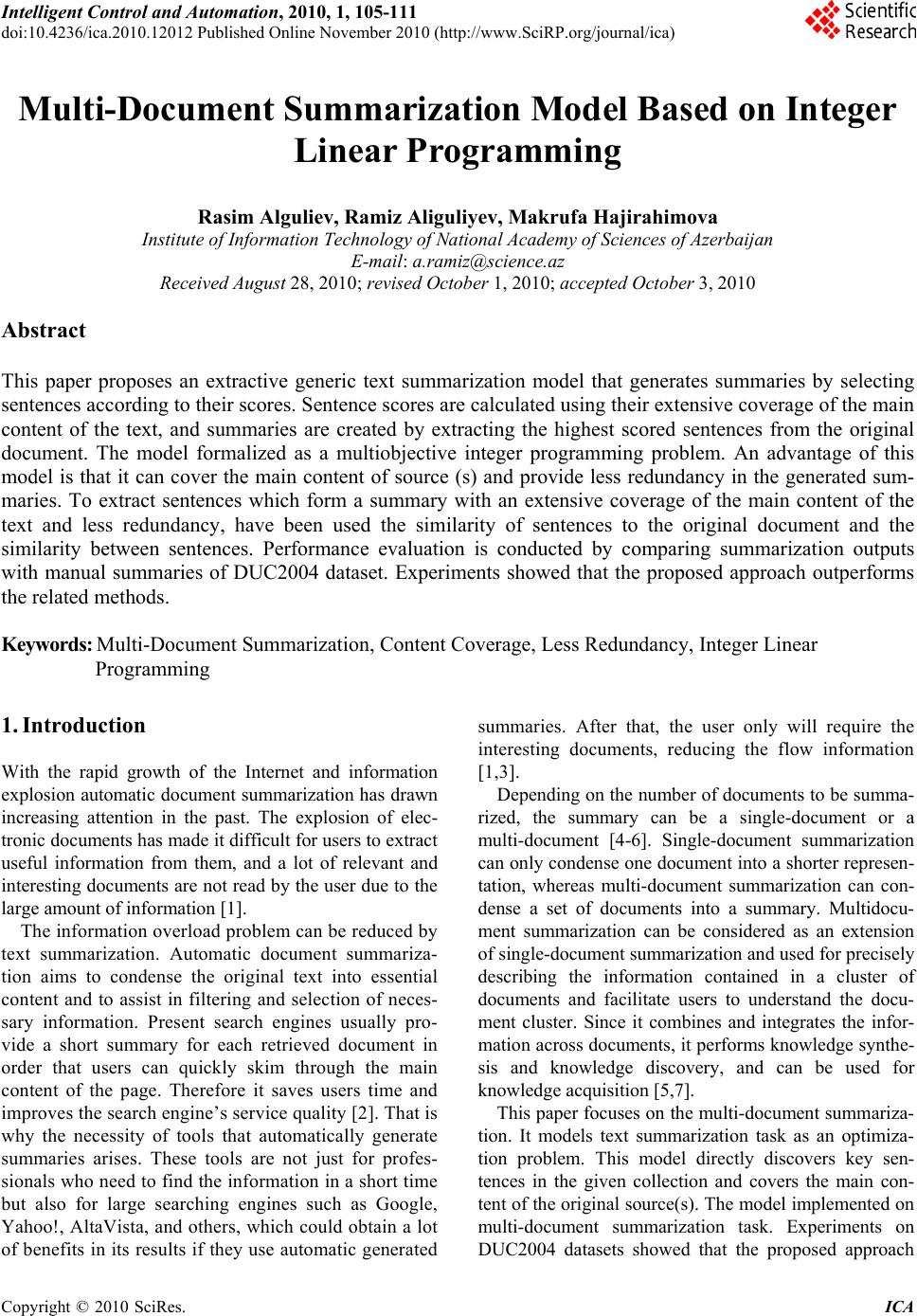 Intelligent Control and Automation, 2010, 1, 105-111 doi:10.4236/ica.2010.12012 Published Online November 2010 (http://www.SciRP.org/journal/ica) Copyright © 2010 SciRes. ICA Multi-Document Summarization Model Based on Integer Linear Programming Rasim Alguliev, Ramiz Aliguliyev, Makrufa Hajirahimova Institute of Information Techno logy of National Academy of Sciences of Azerbaijan E-mail: a.ramiz@science.az Received August 28, 2010; revised October 1, 2010; accepted O c to be r 3, 2010 Abstract This paper proposes an extractive generic text summarization model that generates summaries by selecting sentences according to their scores. Sentence scores are calculated using their extensive coverage of the main content of the text, and summaries are created by extracting the highest scored sentences from the original document. The model formalized as a multiobjective integer programming problem. An advantage of this model is that it can cover the main content of source (s) and provide less redundancy in the generated sum- maries. To extract sentences which form a summary with an extensive coverage of the main content of the text and less redundancy, have been used the similarity of sentences to the original document and the similarity between sentences. Performance evaluation is conducted by comparing summarization outputs with manual summaries of DUC2004 dataset. Experiments showed that the proposed approach outperforms the related methods. Keywords: Multi-Document Summarization, Content Coverage, Less Redundancy, Integer Linear Programming 1. Introduction With the rapid growth of the Internet and information explosion automatic document summarization has drawn increasing attention in the past. The explosion of elec- tronic documents has made it difficult for users to extract useful information from them, and a lot of relevant and interesting documents are not read b y the user due to the large amount of information [1]. The information over load problem can be reduced by text summarization. Automatic document summariza- tion aims to condense the original text into essential content and to assist in filtering and selection of neces- sary information. Present search engines usually pro- vide a short summary for each retrieved document in order that users can quickly skim through the main content of the page. Therefore it saves users time and improves th e search engine’s s ervice quality [2 ]. That is why the necessity of tools that automatically generate summaries arises. These tools are not just for profes- sionals who need to find the information in a short time but also for large searching engines such as Google, Yahoo!, AltaVista, and others, which could obtain a lot of benefits in its resu lts if they use auto matic generated summaries. After that, the user only will require the interesting documents, reducing the flow information [1,3]. Depending on the number of documents to be summa- rized, the summary can be a single-document or a multi-document [4-6]. Single-document summarization can only co ndense one docu ment into a shor ter represen - tation, whereas multi-document summarization can con- dense a set of documents into a summary. Multidocu- ment summarization can be considered as an extension of single-document summarization and used for precisely describing the information contained in a cluster of documents and facilitate users to understand the docu- ment cluster. Since it combines and integrates the infor- mation across documents, it performs knowledge synthe- sis and knowledge discovery, and can be used for knowledge acquisitio n [5,7]. This paper focuses on the multi-do cument summariza- tion. It models text summarization task as an optimiza- tion problem. This model directly discovers key sen- tences in the given collection and covers the main con- tent of the original source(s). The model implemented on multi-document summarization task. Experiments on DUC2004 datasets showed that the proposed approach 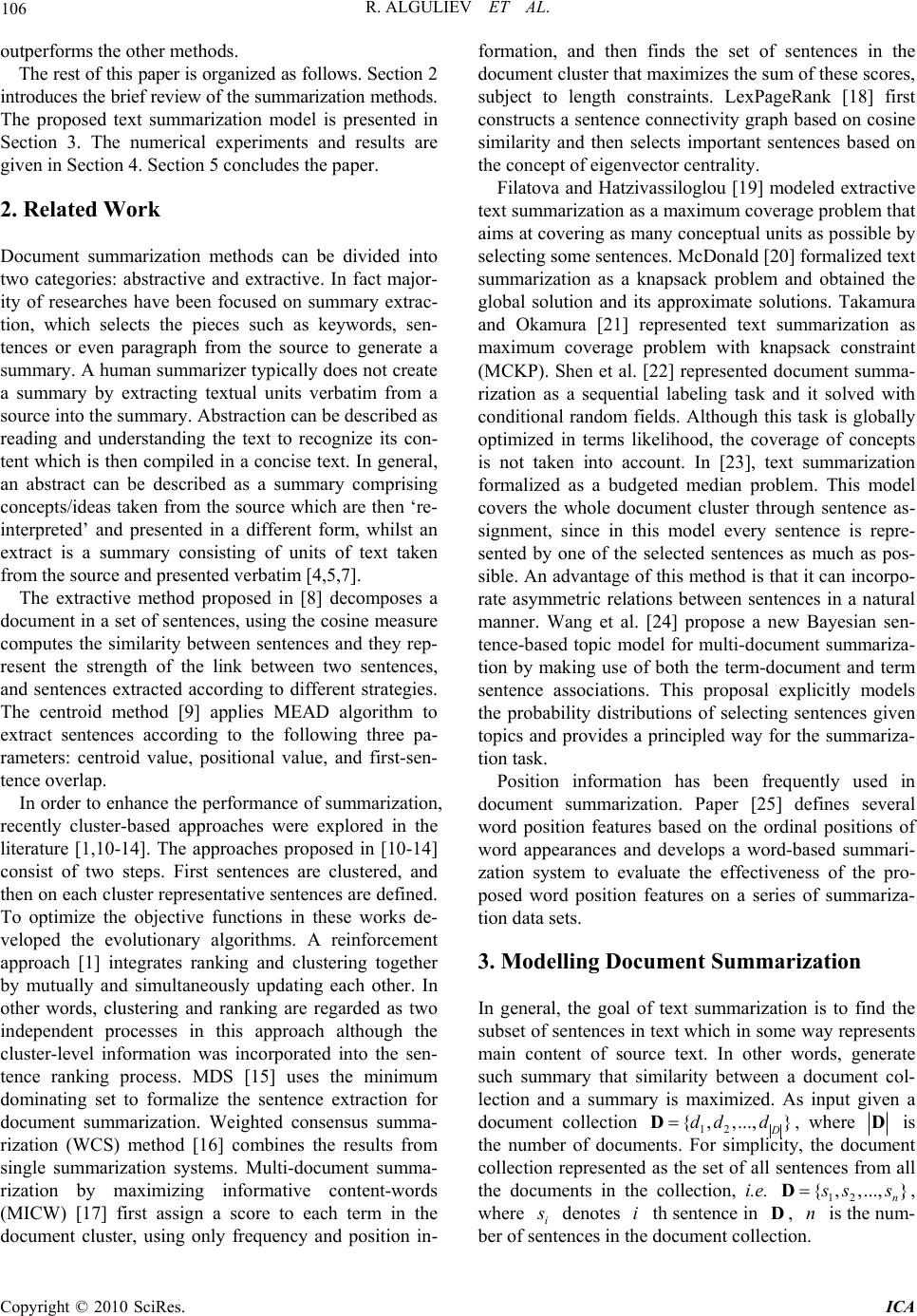 106 R. ALGULIEV ET AL. outperforms the other methods. The rest of this paper is organized as follows. Section 2 introduces the brief review of the summarization methods. The proposed text summarization model is presented in Section 3. The numerical experiments and results are given in Section 4. Section 5 concludes the paper. 2. Related Work Document summarization methods can be divided into two categories: abstractive and extractive. In fact major- ity of researches have been focused on summary extrac- tion, which selects the pieces such as keywords, sen- tences or even paragraph from the source to generate a summary. A human summarizer typically does not create a summary by extracting textual units verbatim from a source into the summary. Abstraction can be described as reading and understanding the text to recognize its con- tent which is then compiled in a con cise text. In general, an abstract can be described as a summary comprising concepts/ideas taken from the source which are then ‘re- interpreted’ and presented in a different form, whilst an extract is a summary consisting of units of text taken from the source and presented verbatim [4,5,7]. The extractive method proposed in [8] decomposes a document in a set of sentences, using the cosine measure computes the similarity between sentences and they rep- resent the strength of the link between two sentences, and sentences extracted according to different strategies. The centroid method [9] applies MEAD algorithm to extract sentences according to the following three pa- rameters: centroid value, positional value, and first-sen- tence overlap. In order to enhance the performance of summarization, recently cluster-based approaches were explored in the literature [1,10-14]. The approaches proposed in [10-14] consist of two steps. First sentences are clustered, and then on each cluster representative sentences are defined. To optimize the objective functions in these works de- veloped the evolutionary algorithms. A reinforcement approach [1] integrates ranking and clustering together by mutually and simultaneously updating each other. In other words, clustering and ranking are regarded as two independent processes in this approach although the cluster-level information was incorporated into the sen- tence ranking process. MDS [15] uses the minimum dominating set to formalize the sentence extraction for document summarization. Weighted consensus summa- rization (WCS) method [16] combines the results from single summarization systems. Multi-document summa- rization by maximizing informative content-words (MICW) [17] first assign a score to each term in the document cluster, using only frequency and position in- formation, and then finds the set of sentences in the document cluster that maximizes the sum of these scores, subject to length constraints. LexPageRank [18] first constructs a sentence connectivity graph based on cosine similarity and then selects important sentences based on the concept of eigenvector centrality. Filatova and Hatzivassiloglou [19] modeled extractive text summarization as a maximum coverage problem that aims at covering as many conceptual units as possible by selecting some sentences. McDonald [20] formalized text summarization as a knapsack problem and obtained the global solution and its approximate solutions. Takamura and Okamura [21] represented text summarization as maximum coverage problem with knapsack constraint (MCKP). Shen et al. [22] represented document summa- rization as a sequential labeling task and it solved with conditional random fields. Although this task is globally optimized in terms likelihood, the coverage of concepts is not taken into account. In [23], text summarization formalized as a budgeted median problem. This model covers the whole document cluster through sentence as- signment, since in this model every sentence is repre- sented by one of the selected sentences as much as pos- sible. An advantage of this method is that it can incorpo- rate asymmetric relations between sentences in a natural manner. Wang et al. [24] propose a new Bayesian sen- tence-based topic model for multi-document summariza- tion by making use of both the term-document and term sentence associations. This proposal explicitly models the probability distributions of selecting sentences given topics and provides a principled way for the summariza- tion task. Position information has been frequently used in document summarization. Paper [25] defines several word position features based on the ordinal positions of word appearances and develops a word-based summari- zation system to evaluate the effectiveness of the pro- posed word position features on a series of summariza- tion data sets. 3. Modelling Document Summarization In general, the goal of text summarization is to find the subset of sentences in text which in some way represents main content of source text. In other words, generate such summary that similarity between a document col- lection and a summary is maximized. As input given a document collection 12 {, ,...,} D dd d D, where D is the number of documents. For simplicity, the document collection represented as the set of all sentences from all the documents in the collection, i.e. 12 { ,,...,} n s ssD, where i s denotes i th sentence in , is the num- ber of sentences in the document collection. Dn Copyright © 2010 SciRes. ICA 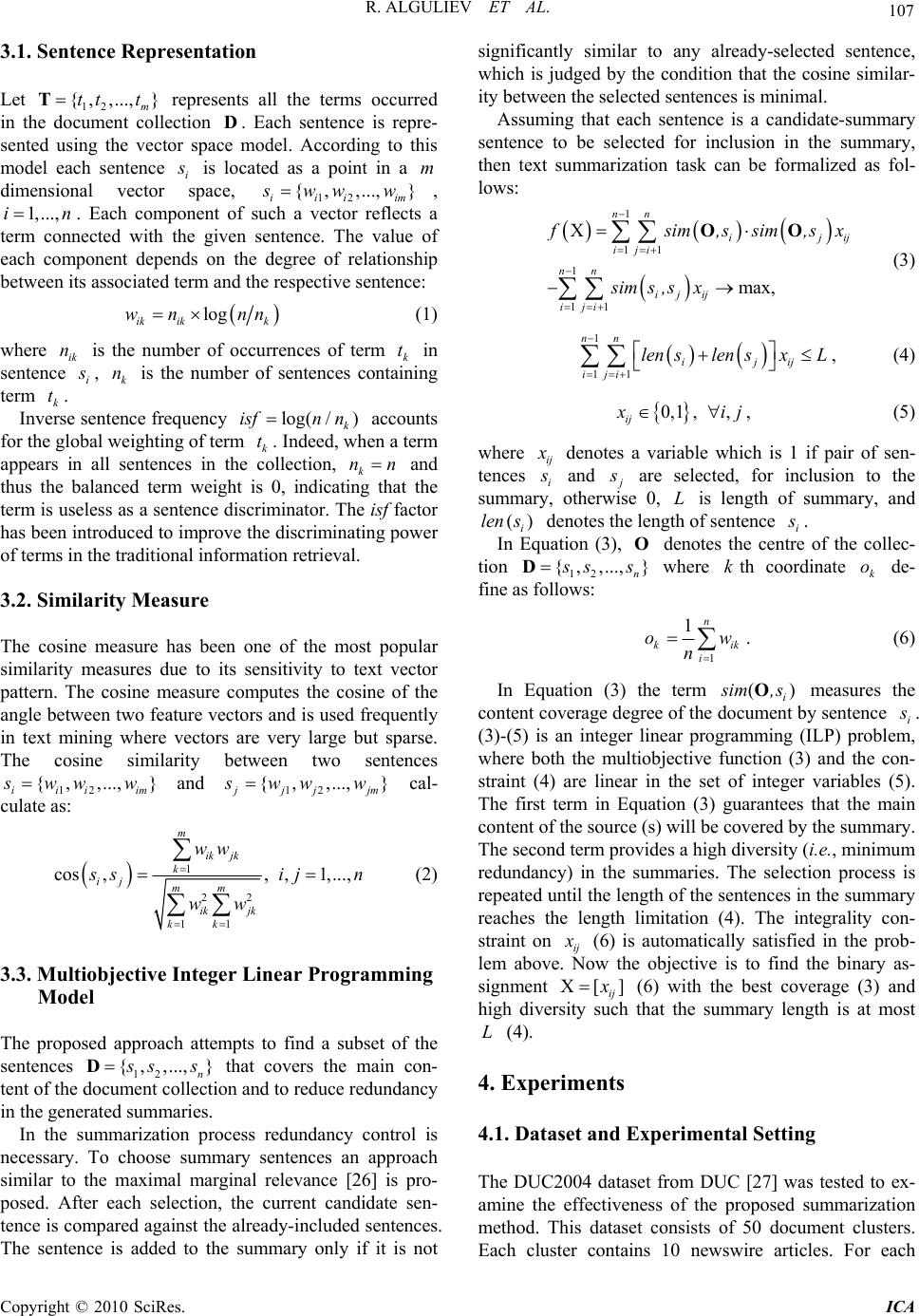 R. ALGULIEV ET AL. 107 3.1. Sentence Representation Let 12 represents all the terms occurred in the document collection . Each sentence is repre- sented using the vector space model. According to this model each sentence i { ,,...,} m tt tTD s is located as a point in a dimensional vector space, 12iii im m }{ ,,..., s ww w, . Each component of such a vector reflects a term connected with the given sentence. The value of each component depends on the degree of relationship between its associated term and the respective sentence: 1,...,in log ik ikk wn nn (1) where ik is the number of occurrences of term k in sentence i n t s , is the number of sentences containing term . k n k Inverse sentence frequency accounts for the global weighting of term k. Indeed, when a term appears in all sentences in the collection, k tlog( /) k isfn n tnn and thus the balanced term weight is 0, indicating that the term is useless as a sentence discriminator. The isf factor has been introduced to improve the discriminating power of terms in the traditional information retrieval. 3.2. Similarity Measure The cosine measure has been one of the most popular similarity measures due to its sensitivity to text vector pattern. The cosine measure computes the cosine of the angle between two feature vectors and is used frequently in text mining where vectors are very large but sparse. The cosine similarity between two sentences 12 { ,,...,} iii im s ww w and 12 { ,,...,} j jj jm swww cal- culate as: 1 22 11 cos,, ,1,..., m ik jk k ij mm ik jk kk ww s si ww jn (2) 3.3. Multiobjective Integer Linear Programming Model The proposed approach attempts to find a subset of the sentences 12 { ,,...,} n s ssD that covers the main con- tent of the document collection and to reduce redundancy in the generated summaries. In the summarization process redundancy control is necessary. To choose summary sentences an approach similar to the maximal marginal relevance [26] is pro- posed. After each selection, the current candidate sen- tence is compared against the already-included sentences. The sentence is added to the summary only if it is not significantly similar to any already-selected sentence, which is judged by the condition that the cosine similar- ity between the selected sentences is minimal. Assuming that each sentence is a candidate-summary sentence to be selected for inclusion in the summary, then text summarization task can be formalized as fol- lows: 1 11 1 11 X max, nn ij iji nn ij ij iji ij f sim ,ssim ,sx sims,sx OO (3) 1 11 nn ijij iji lenslens xL , (4) 0,1 ,, ij x ij, (5) where ij x denotes a variable which is 1 if pair of sen- tences i s and j s are selected, for inclusion to the summary, otherwise 0, is length of summary, and denotes the length of sentence L () i len si s . In Equation (3), denotes the centre of the collec- tion 12 O , } n {, ,... s ss D where th coordinate de- fine as follows: kk o 1 1n k i o n ik w ) . (6) In Equation (3) the term ( i s im ,sO measures the content coverage degree of the document by sentence i s . (3)-(5) is an integer linear programming (ILP) problem, where both the multiobjective function (3) and the con- straint (4) are linear in the set of integer variables (5). The first term in Equation (3) guarantees that the main content of the source (s) will be covered by the summary. The second term provides a high diversity (i.e., minimum redundancy) in the summaries. The selection process is repeated until the length of the sentences in the summary reaches the length limitation (4). The integrality con- straint on ij x (6) is automatically satisfied in the prob- lem above. Now the objective is to find the binary as- signment X[] ij x (6) with the best coverage (3) and high diversity such that the summary length is at most (4). L 4. Experiments 4.1. Dataset and Experimental Setting The DUC2004 dataset from DUC [27] was tested to ex- amine the effectiveness of the proposed summarization method. This dataset consists of 50 document clusters. Each cluster contains 10 newswire articles. For each Copyright © 2010 SciRes. ICA  108 R. ALGULIEV ET AL. group, four NIST assessors were each asked to read all the documents and to create a brief summary. The manu- ally-generated summaries are treated as gold-standard summaries to evaluate the qualities of machine-generated summaries. Following the most relevant previous meth- ods the target length is limited to 665 bytes. In the dataset used in the experiment, the original documents are all pre-processed by sentence segmenta- tion, stop-word removal and word stemming. For re- moving the stopwords we used the stoplist from [28]. In our experiments, stopwords were stemmed by Porter’s stemmer [29]. Solving arbitrary ILPs is an NP-hard problem. How- ever, ILPs are a well studied optimization problem with efficient branch-and-bound algorithms for finding the optimal solution. Since our model is an NP-hard problem, it cannot generally be solved in polynomial time. How- ever, if the size of the problem is limited, sometimes we can obtain the exact solution within a practical time by means of the branch-and-bound method. Modern com- mercial ILP solvers can typically solve moderately large optimizations in a matter of seconds. To solve the opti- mization problem (3)-(5) the GNU Linear Programming kit [30] is used, which is a free optimization package. 4.2. Evaluation Metrics Machine-generated summaries are evaluated using the ROUGE-1.5.5 (Recall-Oriented Understudy for Gisting Evaluation) package [31]. ROUGE is adopted by DUC as the official evaluation metric for text summarization. It includes measures, ROUGE-N, ROUGE-L, ROUGE-W, ROUGE-S and ROUGE-SU, which automatically deter- mine the quality of machine summary by comparing it to ideal summaries created by humans. These measures evaluate the quality of the summarization by counting the number of overlapping units, such N-grams, between the generated summary by a method and a set of refer- ence summaries. Basically, the ROUGE-N measure compares N-grams of two summaries, and counts the number of matches. This measure is computed as [31]: Ngram N-gram N -g ram ROUGE-N N-gram ref ref match S SummS S SummS Count Count , (7) where N stands for the length of the N-gram, (N-gram) match Count is the max imu m nu mb er o f N -gr ams co-occurring in candidate summary and the set of refer- ence-summaries. (N-gram ) Count is the number of N- grams in the reference summaries. For evaluation, are used the ROUGE-1 and ROUGE-2 metrics. ROUGE-1 and ROUGE-2 compares the uni- gram and bigram overlap between the system summary and the manual summaries created by human, respect- tively. 4.3. Performance Evaluation The following methods as the baseline systems are used to compare with the proposed method (denoted as ILPS): 1) Centroid [9]; 2) LexPageRank [18]; 3) BSTM [24]; 4) MICW [17]; 5) MCKP [21]; 6) WCS [16]; 7) Re- in- forcement [1]; 8) MDS [15]. The experimental results are shown in Table 1. The ILPS method outperforms the simple Centroid method and another graph-based LexPageRank, and its perform- ance is close to the results of the Bayesian sentence- based topic model and those of the best team in the DUC competition. Note however that, like clustering or topic based methods, BSTM needs the topic number as the input, which usually varies by different summarization tasks and is hard to estimate. With comparison to the average ROUGE values for other methods, the proposed method can achieve signify- cant improvement. Results of comparison reported in Table 2. Improvement refers to the difference between the ROUGE scores and the relative improvement in the parentheses when ILPS is compared to other methods. The relative improvement is calculated as ( when is compared to . Results of comparison re- ported in Table 2. )*100 /ba a ba For more evident representation the comparisons of the methods are reported on F i gures 1 and 2. Table 1. ROUGE values of the methods. Methods ROUGE-1 ROUGE-2 MCKP 0.30908 0.08042 MICW 0.32714 0.08609 Centroid 0.36728 0.07379 Reinforcement 0.37082 0.08351 LexPageRank 0.37842 0.08572 MDS 0.37934 0.08934 DUC Best 0.38224 0.09216 BSTM 0.39065 0.09010 ILPS 0.39121 0.09113 WCS 0.39825 0.09641 Copyright © 2010 SciRes. ICA 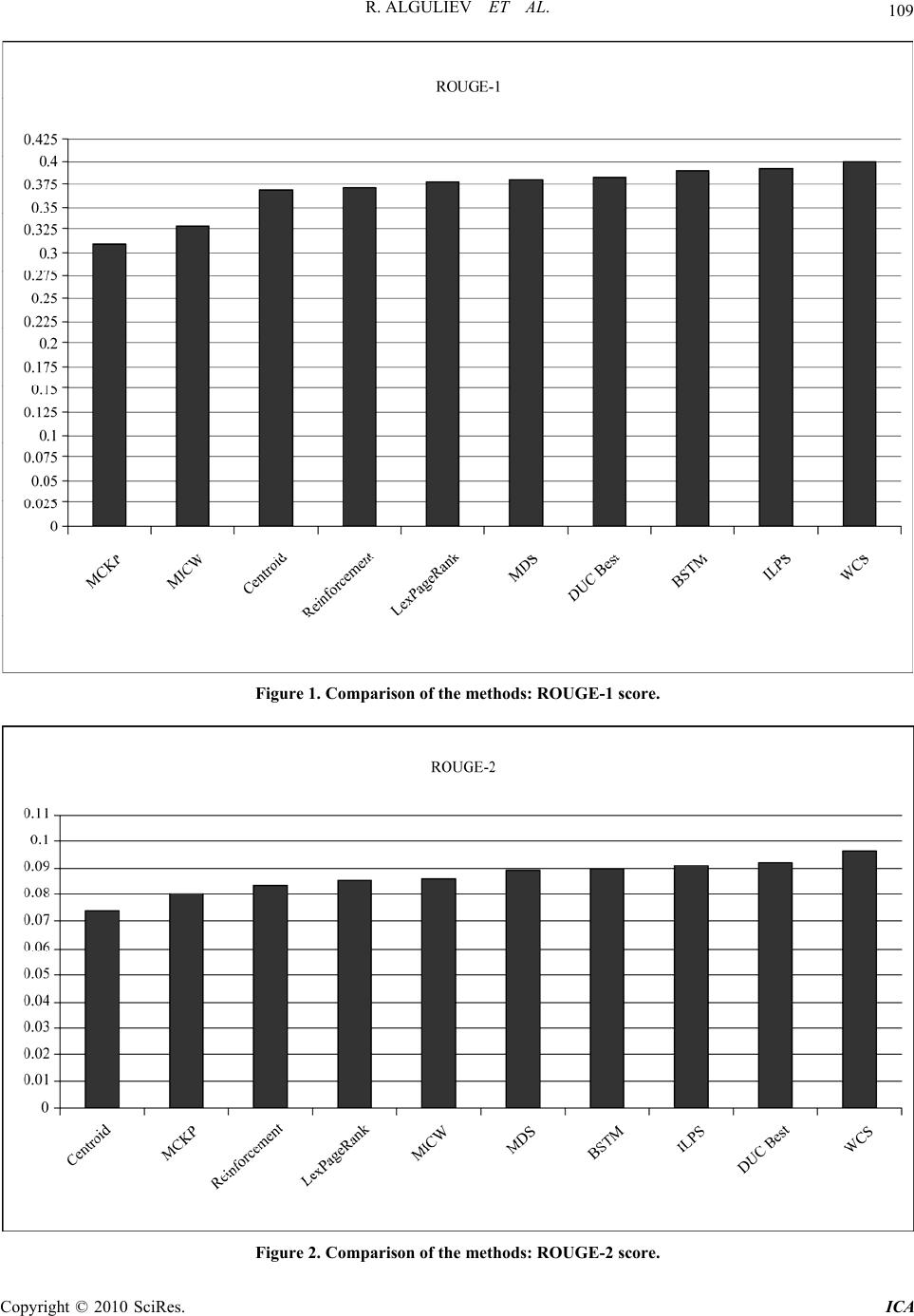 R. ALGULIEV ET AL. Copyright © 2010 SciRes. ICA 109 Figure 1. Comparison of the methods: ROUGE-1 score. Figure 2. Comparison of the methods: ROUGE-2 score. 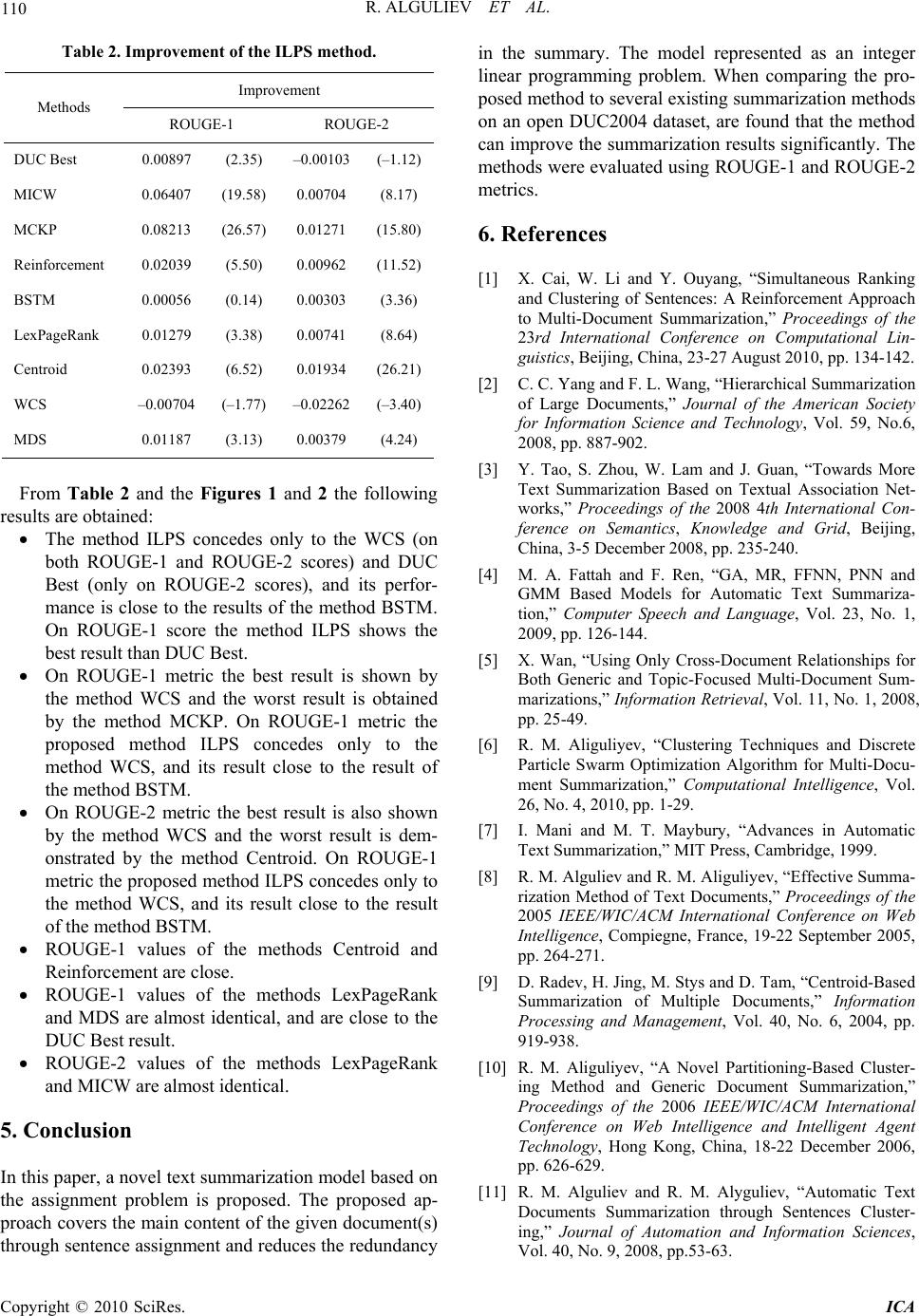 R. ALGULIEV ET AL. Copyright © 2010 SciRes. ICA 110 Table 2. Improvement of the ILPS method. Improvement Methods ROUGE-1 ROUGE-2 DUC Best 0.00897 (2.35) –0.00103 (–1.12) MICW 0.06407 (19.58) 0.00704 (8.17) MCKP 0.08213 (26.57) 0.01271 (15.80) Reinforcement 0.02039 (5.50) 0.00962 (11.52) BSTM 0.00056 (0.14) 0.00303 (3.36) LexPageRank 0.01279 (3.38) 0.00741 (8.64) Centroid 0.02393 (6.52) 0.01934 (26.21) WCS –0.00704 (–1.77) –0.02262 (–3.40) MDS 0.01187 (3.13) 0.00379 (4.24) From Table 2 and the Figures 1 and 2 the following results are obtained: The method ILPS concedes only to the WCS (on both ROUGE-1 and ROUGE-2 scores) and DUC Best (only on ROUGE-2 scores), and its perfor- mance is close to the results of the method BSTM. On ROUGE-1 score the method ILPS shows the best result than DUC Best. On ROUGE-1 metric the best result is shown by the method WCS and the worst result is obtained by the method MCKP. On ROUGE-1 metric the proposed method ILPS concedes only to the method WCS, and its result close to the result of the method BSTM. On ROUGE-2 metric the best result is also shown by the method WCS and the worst result is dem- onstrated by the method Centroid. On ROUGE-1 metric the proposed method ILPS concedes only to the method WCS, and its result close to the result of the method BSTM. ROUGE-1 values of the methods Centroid and Reinforcement are close. ROUGE-1 values of the methods LexPageRank and MDS are almost identical, and are close to the DUC Best result. ROUGE-2 values of the methods LexPageRank and MICW are almost identical. 5. Conclusion In this paper, a novel text summarization model based on the assignment problem is proposed. The proposed ap- proach covers the main content of the given document(s) through sentence assignment and reduces the redundancy in the summary. The model represented as an integer linear programming problem. When comparing the pro- posed method to several existing summarization methods on an open DUC2004 dataset, are found that the method can improve the summarization results significantly. The methods were evaluated using ROUGE-1 and ROUGE-2 metrics. 6. References [1] X. Cai, W. Li and Y. Ouyang, “Simultaneous Ranking and Clustering of Sentences: A Reinforcement Approach to Multi-Document Summarization,” Proceedings of the 23rd International Conference on Computational Lin- guistics, Beijing, China, 23-27 August 2010, pp. 134-142. [2] C. C. Yang and F. L. Wang, “Hierarchical Summarization of Large Documents,” Journal of the American Society for Information Science and Technology, Vol. 59, No.6, 2008, pp. 887-902. [3] Y. Tao, S. Zhou, W. Lam and J. Guan, “Towards More Text Summarization Based on Textual Association Net- works,” Proceedings of the 2008 4th International Con- ference on Semantics, Knowledge and Grid, Beijing, China, 3-5 December 2008, pp. 235-240. [4] M. A. Fattah and F. Ren, “GA, MR, FFNN, PNN and GMM Based Models for Automatic Text Summariza- tion,” Computer Speech and Language, Vol. 23, No. 1, 2009, pp. 126-144. [5] X. Wan, “Using Only Cross-Document Relationships for Both Generic and Topic-Focused Multi-Document Sum- marizations,” Information Retrieval, Vol. 11, No. 1, 2008, pp. 25-49. [6] R. M. Aliguliyev, “Clustering Techniques and Discrete Particle Swarm Optimization Algorithm for Multi-Docu- ment Summarization,” Computational Intelligence, Vol. 26, No. 4, 2010, pp. 1-29. [7] I. Mani and M. T. Maybury, “Advances in Automatic Text Summarization,” MIT Press, Cambridge, 1999. [8] R. M. Alguliev and R. M. Aliguliyev, “Effective Summa- rization Method of Text Documents,” Proceedings of the 2005 IEEE/WIC/ACM International Conference on Web Intelligence, Compiegne, France, 19-22 September 2005, pp. 264-271. [9] D. Radev, H. Jing , M. Sty s and D. Tam, “Centroi d-Based Summarization of Multiple Documents,” Information Processing and Management, Vol. 40, No. 6, 2004, pp. 919-938. [10] R. M. Aliguliyev, “A Novel Partitioning-Based Cluster- ing Method and Generic Document Summarization,” Proceedings of the 2006 IEEE/WIC/ACM International Conference on Web Intelligence and Intelligent Agent Technology, Hong Kong, China, 18-22 December 2006, pp. 626-629. [11] R. M. Alguliev and R. M. Alyguliev, “Automatic Text Documents Summarization through Sentences Cluster- ing,” Journal of Automation and Information Sciences, Vol. 40, No. 9, 2008, pp.53-63. 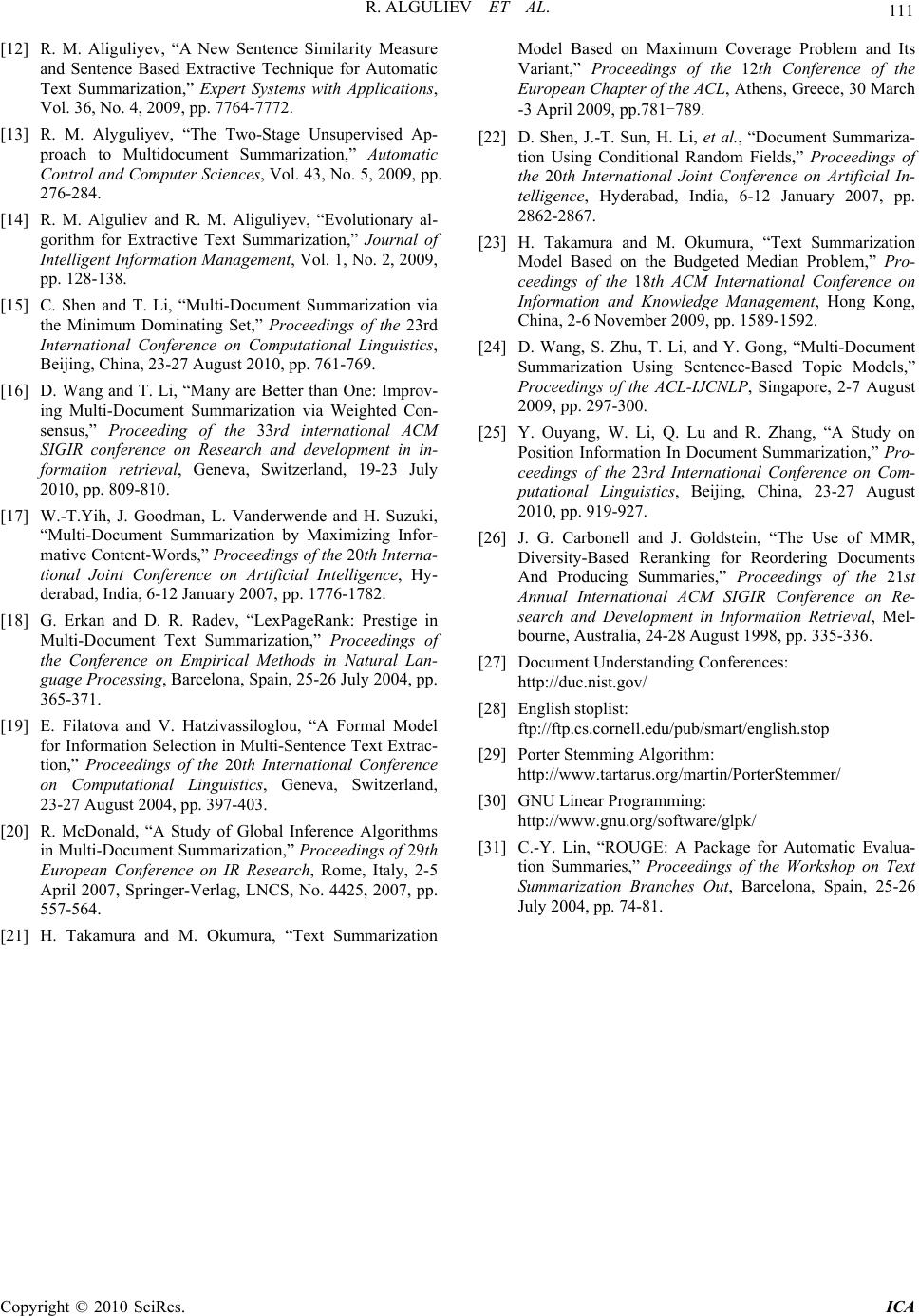 R. ALGULIEV ET AL. 111 [12] R. M. Aliguliyev, “A New Sentence Similarity Measure and Sentence Based Extractive Technique for Automatic Text Summarization,” Expert Systems with Applications, Vol. 36, No. 4, 2009, pp. 7764-7772. [13] R. M. Alyguliyev, “The Two-Stage Unsupervised Ap- proach to Multidocument Summarization,” Automatic Control and Computer Sciences, Vol. 43, No. 5, 2009, pp. 276-284. [14] R. M. Alguliev and R. M. Aliguliyev, “Evolutionary al- gorithm for Extractive Text Summarization,” Journal of Intelligent Information Management, Vol. 1, No. 2, 2009, pp. 128-138. [15] C. Shen and T. Li, “Multi-Document Summarization via the Minimum Dominating Set,” Proceedings of the 23rd International Conference on Computational Linguistics, Beijing, China, 23-27 August 2010, pp. 761-769. [16] D. Wang and T. Li, “Many are Better than One: Improv- ing Multi-Document Summarization via Weighted Con- sensus,” Proceeding of the 33rd international ACM SIGIR conference on Research and development in in- formation retrieval, Geneva, Switzerland, 19-23 July 2010, pp. 809-810. [17] W.-T.Yih, J. Goodman, L. Vanderwende and H. Suzuki, “Multi-Document Summarization by Maximizing Infor- mative Content-Words,” Proceedings of the 20th Interna- tional Joint Conference on Artificial Intelligence, Hy- derabad, India, 6-12 January 2007, pp. 1776-1782. [18] G. Erkan and D. R. Radev, “LexPageRank: Prestige in Multi-Document Text Summarization,” Proceedings of the Conference on Empirical Methods in Natural Lan- guage Processing, Barcelona, Spain, 25-26 July 2004, pp. 365-371. [19] E. Filatova and V. Hatzivassiloglou, “A Formal Model for Information Selection in Multi-Sentence Text Extrac- tion,” Proceedings of the 20th International Conference on Computational Linguistics, Geneva, Switzerland, 23-27 August 2004, pp. 397-403. [20] R. McDonald, “A Study of Global Inference Algorithms in Multi-Document Summarization,” Proceedings of 29th European Conference on IR Research, Rome, Italy, 2-5 April 2007, Springer-Verlag, LNCS, No. 4425, 2007, pp. 557-564. [21] H. Takamura and M. Okumura, “Text Summarization Model Based on Maximum Coverage Problem and Its Variant,” Proceedings of the 12th Conference of the European Chapter of the ACL, Athens, Greece, 30 March -3 April 2009, pp.781‒789. [22] D. Shen, J.-T. Sun, H. Li, et al., “Document Summariza- tion Using Conditional Random Fields,” Proceedings of the 20th International Joint Conference on Artificial In- telligence, Hyderabad, India, 6-12 January 2007, pp. 2862-2867. [23] H. Takamura and M. Okumura, “Text Summarization Model Based on the Budgeted Median Problem,” Pro- ceedings of the 18th ACM International Conference on Information and Knowledge Management, Hong Kong, China, 2-6 November 2009, pp. 1589-1592. [24] D. Wang, S. Zhu, T. Li, and Y. Gong, “Multi-Document Summarization Using Sentence-Based Topic Models,” Proceedings of the ACL-IJCNLP, Singapore, 2-7 August 2009, pp. 297-300. [25] Y. Ouyang, W. Li, Q. Lu and R. Zhang, “A Study on Position Information In Document Summarization,” Pro- ceedings of the 23rd International Conference on Com- putational Linguistics, Beijing, China, 23-27 August 2010, pp. 919-927. [26] J. G. Carbonell and J. Goldstein, “The Use of MMR, Diversity-Based Reranking for Reordering Documents And Producing Summaries,” Proceedings of the 21st Annual International ACM SIGIR Conference on Re- search and Development in Information Retrieval, Mel- bourne, Australia, 24-28 August 1998, pp. 335-336. [27] Document Understanding Conferences: http://duc.nist.gov/ [28] English stoplist: ftp://ftp.cs.cornell.edu/pub/smart/english.stop [29] Porter Stemming Algorithm: http://www.tartarus.org/martin/PorterStemmer/ [30] GNU Linear Programming: http://www.gnu.org/software/glpk/ [31] C.-Y. Lin, “ROUGE: A Package for Automatic Evalua- tion Summaries,” Proceedings of the Workshop on Text Summarization Branches Out, Barcelona, Spain, 25-26 July 2004, pp. 74-81. Copyright © 2010 SciRes. ICA |

